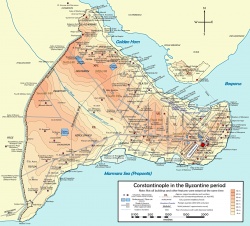Church of the Virgin of Blachernae (Istanbul)
The Church of Panagia Blachernae (full name in Greek: Θεοτòκος τών Βλαχερνών (pr. Theotókos tón Blachernón); Turkish name: Meryem Ana Kilisesi) is located in Istanbul, in the district of Fatih, in the neighbourhood of Ayvansaray, along Mustafa Paşa Bostanı Sokak. It lies a few hundred meters inside the walled city, at a short distance from the shore of the Golden Horn. The building is protected by a high wall, and preceded by a garden.
History
The church is near the northern tip of the walls of Theodosius built by the Empress Pulcheria (ca. 450-453), and her husband, Emperor Marcian (450-457). They had the church built on the site of a sacred spring, which was a place of pilgrimage near the shore of the Golden Horn (known as Ayvansaray today). Inside is now the best known and most celebrated sanctuary to the Virgin Mary in Constantinople. Emperor Leo I (457-474) completed the church by adding the "Hagiasma" [1]. [2]He also built the "Hagion Lousma" [3].
Emperor Leo I also built the circular pareklision Hagia Soros (chapel), next to the church to contain the holy robe and girdle of the Virgin Mary, brought from Palestine in 458 (or 473). The chapel of the Virgin's robe was covered in silver and considered a "reliquary of architectural dimensions." Lay people were not allowed inside but could pray in the main church.[4] This very shrine housed the miracle-working icon of the Blachernitissa.
In 625-626, Constantinople was attacked by the Avards. Emperor Heraclius (575-641) campaigned against the Persians, however, the icon was carried in a procession along the city walls and so the saving of the city was attributed to the intervention of the Theotokos. In order to protect the sanctuary, and the city from such a siege, Leo I added the famous quarter of Blachernae in 627, with its venerated church, whose image was now considered the palladium of Constantinople. The circumference of the walls were then, and still are, eleven to twelve miles. By this stage, the church of Blachernae had around 75 endowed clerics.
During the iconoclastic period, and according to tradition, the icon disappeared and was then found hidden behind a wall during renovation works in 1030.
The church was burnt down in 1070 and rebuilt by the year 1077 either by Romanos IV Diogenes (1067-78) or Michael VII (1071-87) and then destroyed again by fire in 1434. The church, at this stage, was connected to the Palace of Blachernae by a stairway. After the fire, nothing remained of the fire apart from the Sacred Spring.
In 1867, the modern church was built and further additions have since been made to the structure. It is said, that the Akathistos was first chanted at this location and a special marble plaque, inscribed with the Akathistos verse, a celebrated Byzantine hymn, to the Theotokos, has now been placed above the Hagiasma. In addition, there are four wall paintings by the famous painter Eirenarchos Covas (1964)
To this very day, the spring is reputed to have therapeutic powers. Also associated with the history of this shrine is:
- the history of the Palace of Blachernae;
- the history of the Monastery of the Hodegetria
- the icon, the Panagia Hagiosoritissa.[5];
- a procession, originating from the time of the Patriarch Timotheos [511-18]—the "panhgur j"—which would take place every Friday from Blachernai to the Church of the Chalkoprateia, near Hagia Sophia, at the other end of the city.[6];
- the Eastern Council of Blachernae (Constantinople) in 1285. At this council, a significant statement was produced addressing the theological issue of the 'Filioque'. Despite the concern of Byzantine theologians to oppose the idea of the Filioque and its addition to the creed, there is no reference to it in the Synodikon of Orthodoxy [7];
- the original icon of Tikhvin (Hodegetria), painted by the Holy Apostle Luke and kept in the Church of Blachernae for about five hundred years. It was sent to Russia in 1383, before the fall of Constantinople. It is said that fishermen saw it surrounded in lights over the Lake of Ladoga in Russia. The icon was later found on the bank of the Tikhvin River and was placed in the local church. Recently, the icon was kept in Chicago and returned to Russia.
References
- ↑ the Hagiasma in this case, is the fountain of holy water where water flowed out of the hands of the marble statue of the Virgin Mary
- ↑ Oxford Dictionary of Byzantium (ODB) 1:293; Janin, Eglises CP, 161-71 and the end map entitled "Byzance Constantinople," ref. D2; George P. Majeska, Russian Travelers to Constantinople in the Fourteenth and Fifteenth Centuries, (Washington, D.C.: 1984), 333-337.
- ↑ the Hagion Lousma was a sacred pool where the emperors would participate in a bathing purification ritual
- ↑ ODB 3:1929.
- ↑ ODB 3:2171.
- ↑ Janin, Eglises CP, 177.
- ↑ a collection containing more than sixty anathemas representing the doctrinal decisions of Eastern councils through the fourteenth century.
See also
- District of the Phanar and the Keratius gulf part of the Church of Constantinople, within the geographical area of Istanbul.
- Panagia Blachernitissa icon
- History of the "Yper Maxo Stratigo"
